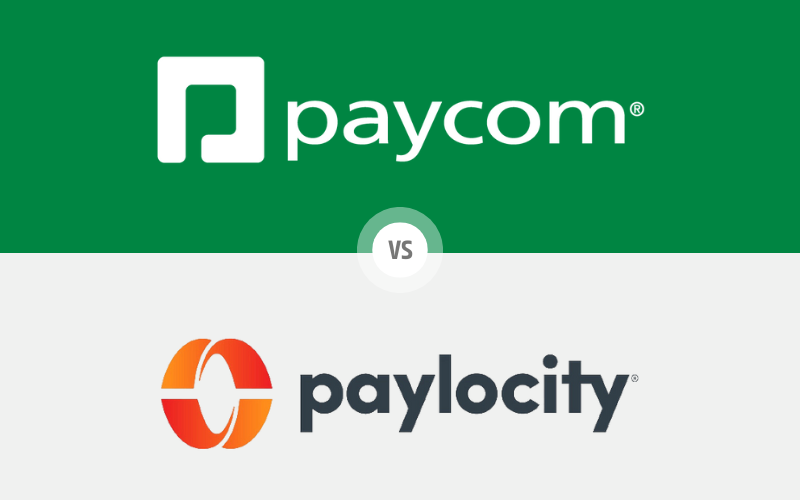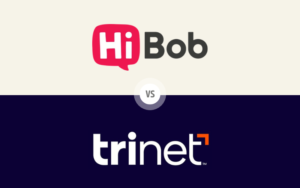When considering Paycom vs Paylocity, businesses are faced with two robust Human Capital Management (HCM) systems, each offering unique strengths and capabilities. Selecting the right HCM software is crucial for effectively managing your workforce and optimizing HR operations. This blog post delves into a detailed comparison of Paycom and Paylocity, covering essential topics like user interface, core HR functions, payroll management, and more. Our goal is to provide you with comprehensive insights to help you make an informed decision on which platform best fits your organizational needs and goals. Whether you’re looking to enhance HR functionalities, streamline processes, or improve employee engagement and productivity, understanding the nuances between Paycom and Paylocity is key. Let’s explore these systems and discover which might be the right choice for your business.
Table of Contents
User Interface and User Experience
When choosing between Paycom vs Paylocity, it’s essential to consider how their user interfaces (UI) and user experiences (UX) stand up against each other. This comparison will delve into the design, functionality, and overall ease of use, providing a clear overview for businesses deciding which software better fits their needs.

Paycom User Interface and User Experience
Paycom offers a streamlined interface that is highly intuitive, making it accessible for users of all tech levels. The platform emphasizes a direct approach to navigation, allowing users to perform tasks with minimal clicks. This efficiency is crucial in reducing the time spent on daily tasks, thereby boosting productivity.
Key Features of Paycom UI/UX:
- Intuitive Design: The layout is straightforward, which helps new users to quickly become proficient without extensive training.
- Customizable Dashboards: Users can personalize their dashboards to highlight the most frequently used features, enhancing the user experience.
- Mobile Optimization: Paycom provides a robust mobile app that replicates the desktop experience, ensuring functionality on-the-go.
Paylocity User Interface and User Experience
Paylocity presents a modern interface that focuses on user engagement and interaction. The design is visually appealing, which can be a significant factor in user satisfaction and long-term user engagement. Paylocity also offers extensive customization options, allowing each organization to tailor the system to their specific needs.
Key Features of Paylocity UI/UX:
- Engaging Aesthetics: The platform uses contemporary design elements that are not only pleasing to the eye but also make daily navigation enjoyable.
- Advanced Customization: Users have the capability to adjust layouts, add widgets, and access a variety of integration tools that enhance the software’s utility.
- Interactive Elements: Features such as social feeds, peer recognition, and interactive communication tools make it a standout for promoting workplace collaboration.
Comparison and Conclusion
In the comparison of Paycom vs Paylocity regarding user interface and user experience, both platforms offer strong features but cater to slightly different user preferences. Paycom is excellent for organizations looking for a straightforward, efficient tool that employees can quickly adapt to and use effectively. Its strong mobile platform is also a key benefit for teams needing access across multiple devices.
On the other hand, Paylocity may be more appealing to those who prioritize a visually engaging interface with more opportunities for customization and employee interaction. Its focus on incorporating social features suggests a broader approach to how HR software can impact company culture and employee engagement.
Ultimately, the choice between Paycom and Paylocity will depend on the specific needs and priorities of your organization. If simplicity and efficiency are your top priorities, Paycom might be the better choice. However, if you want a more engaging and customizable platform, Paylocity could be the way to go. Each offers distinct advantages that can enhance your HR operations and improve user satisfaction.
Core HR Functions
Understanding the core HR functionalities of Paycom vs Paylocity is essential for any organization that seeks to optimize its HR operations. Both platforms offer robust tools designed to streamline core HR tasks, but they do so with different emphases and capabilities. Here’s a detailed look at how each system handles these fundamental aspects.

Paycom Core HR Functions
Paycom offers a comprehensive suite of HR tools that centralize and automate key HR tasks. This integrated approach ensures that all employee data is managed within a single system, reducing the likelihood of errors and discrepancies, and enhancing overall HR efficiency.
Key Features of Paycom Core HR Functions:
- Comprehensive Employee Lifecycle Management: From recruitment to retirement, Paycom provides tools that manage every stage of an employee’s journey within a single, integrated system.
- Automated Data Entry: Reduces the need for manual entry and increases data accuracy with automated systems that integrate new hire information across all relevant HR processes.
- Self-Service Portal: Empowers employees to update their personal information, access pay stubs, and manage benefits, which reduces administrative burden on HR staff and enhances the employee-driven payroll experience.
Paylocity Core HR Functions
Paylocity stands out with its highly customizable core HR solutions that cater to the unique needs of each business. It offers flexibility in how HR processes are managed and how data is handled, making it a suitable choice for businesses that require tailored HR solutions.
Key Features of Paylocity Core HR Functions:
- Customizable Workflows: Users can configure workflows to match their company’s specific processes, which enhances adaptability and response to organizational changes.
- Integrated Payroll and Benefits: Seamless integration with payroll and benefits modules ensures accurate and efficient administration of employee compensation and benefits, with benefits administration syncing directly with payroll.
- Robust Reporting Tools: Advanced reporting capabilities allow for the creation of detailed reports to support decision-making and compliance with regulatory requirements, including access to over 100 reports for time tracking alone.
Comparison and Conclusion
In the Paycom vs Paylocity comparison of core HR functions, both platforms offer compelling features but serve slightly different organizational needs. Paycom’s strength lies in its integrated approach that simplifies the management of employee information across the entire lifecycle. This is ideal for larger organizations looking for a streamlined, all-in-one solution to manage their HR tasks efficiently.
Paylocity, however, provides greater customization and flexibility, which may be more appealing to medium-sized organizations that have specific needs or complex HR processes. Its ability to adapt workflows and integrate with over 350 third-party tools makes it a versatile choice for businesses looking to tailor their HR systems to their unique operational demands.
Both Paycom and Paylocity offer the fundamentals of what a solid payroll and HR platform should do. Choosing between them will depend largely on your organization’s specific requirements: whether you value streamlined, straightforward efficiency or customizable, adaptable functionality. Paycom might be better suited for larger organizations seeking an integrated system, while Paylocity could be ideal for medium-sized businesses focusing on employee engagement and customization. Both systems offer robust core HR functionalities that can significantly improve your HR operations and workforce management.
Payroll Management
Payroll management is a critical function for any business, demanding accuracy, compliance, and efficiency. Exploring Paycom vs Paylocity in the context of payroll management can help you decide which system might best meet your organization’s needs. Both platforms offer sophisticated tools to streamline payroll processes, but they have distinct approaches and features.

Paycom Payroll Management
Paycom provides a fully integrated payroll system that emphasizes simplicity and accuracy. Its payroll management is deeply integrated with other HR functions, which helps to ensure that data across the platform is consistent and up-to-date. This integration is vital for minimizing errors and simplifying the payroll process.
Key Features of Paycom Payroll Management:
- Single-Application Solution: Paycom operates from a single database, meaning payroll data is always aligned with other HR records without the need for manual synchronization.
- Real-Time Payroll Processing: Allows for immediate preview and adjustments before finalizing payroll, ensuring accuracy and reducing the likelihood of errors.
- Comprehensive Tax Management: Automatically calculates and files payroll taxes, which helps to ensure compliance with federal, state, and local regulations.
- Employee-Driven Payroll Experience: Empowers employees to manage their own payroll information, reducing administrative burden on HR staff.
Paylocity Payroll Management
Paylocity offers a flexible and user-friendly payroll solution designed to cater to the modern workforce. It provides various tools to automate payroll tasks and enhance the overall user experience, both for administrators and employees.
Key Features of Paylocity Payroll Management:
- Pre-Process Payroll Visibility: Offers a detailed preview of payroll results before submission, which allows for corrections and adjustments to be made in advance.
- Customizable Payroll Features: Supports a variety of payment methods and allows for easy adjustments to pay rates, bonuses, and deductions.
- Integrated Time Tracking: Seamlessly integrates with time and attendance systems to ensure accurate pay based on actual hours worked, including overtime and double-time calculations.
- Global Payroll Support: Supports domestic and global payroll for employees in over 100 countries, catering to businesses with an international workforce.
Comparison and Conclusion
When comparing Paycom vs Paylocity in terms of payroll management, both platforms offer robust functionalities designed to streamline the complex process of payroll administration. Paycom’s strength lies in its comprehensive integration within a single application, ensuring that all information is synchronized across HR processes. This can be particularly beneficial for larger organizations that prioritize data integrity and error reduction in their payroll operations.
On the other hand, Paylocity may be more appealing for medium-sized businesses looking for flexibility and extensive customization options in their payroll system. Its user-friendly interface, detailed pre-processing visibility, and global payroll support make it an excellent choice for businesses that need a more adaptable payroll solution and have an international presence.
Ultimately, the decision between Paycom and Paylocity for payroll management will depend on your specific business needs, including the level of integration required, the complexity of your payroll processes, and the degree of customization you need. Both platforms provide powerful tools that can help ensure your payroll is accurate, compliant, and efficiently managed, with Paycom and Paylocity both offering the fundamentals of what a solid payroll and HR platform should do.
Time and Attendance Tracking
Effective time and attendance tracking is essential for accurate payroll processing and workforce management. In comparing Paycom vs Paylocity, it’s important to understand how each platform facilitates these functions and what distinct advantages they offer to businesses looking to enhance or streamline their timekeeping practices.

Paycom Time and Attendance Tracking
Paycom offers a robust time and attendance system that is fully integrated with its payroll and HR management modules. This integration ensures a seamless flow of data, reducing the potential for errors and making it easier to manage employee hours in real-time.
Key Features of Paycom Time and Attendance Tracking:
- Comprehensive Integration: Seamless integration with payroll and HR modules ensures that timekeeping data directly influences payroll calculations and employee records.
- Real-Time Data Access: Managers and HR professionals can access and process timekeeping data in real time, enabling proactive management of overtime and compliance with labor laws.
- Employee Self-Service: Employees can clock in and out using mobile devices, view their schedules, and submit time-off requests, all from the same system.
- Time Clocks and Theft Prevention: Offers physical time clock options and features to prevent time theft, enhancing security and accuracy in time tracking.
Paylocity Time and Attendance Tracking
Paylocity provides a flexible and highly customizable time and attendance tracking system, designed to accommodate the diverse needs of modern workplaces. It offers various tools that enhance the user experience and provide detailed insights into labor data.
Key Features of Paylocity Time and Attendance Tracking:
- Customizable Features: Allows businesses to tailor the system to their specific needs, including setting up custom rules for attendance, overtime, and leave management.
- Interactive Dashboards: Managers have access to interactive dashboards that display essential information, such as employee attendance trends, in real time.
- Mobile Compatibility: Offers iOS and Android-compatible mobile apps that enable employees to clock in and out remotely, check their schedules, and manage their time off, enhancing flexibility and connectivity.
- Extensive Reporting: Provides over 100 reports and syncs directly with payroll, offering real-time visibility into labor costs and wage variances on schedules and timesheets.
Comparison and Conclusion
In the debate between Paycom vs Paylocity for time and attendance tracking, both platforms provide strong capabilities but cater to different preferences and needs. Paycom’s integrated approach is particularly valuable for organizations that want a unified system where payroll, HR, and timekeeping data are closely interconnected, reducing the burden of managing separate systems and minimizing errors.
Paylocity, on the other hand, may be more suitable for organizations that prioritize customization and flexibility in their time and attendance systems. Its customizable features, interactive dashboards, and extensive reporting capabilities make it easy to adapt to various operational requirements and provide managers with powerful tools to analyze workforce efficiency.
Choosing between Paycom and Paylocity will largely depend on the specific needs of your organization, such as the level of integration desired, the complexity of your workforce management, and the need for customization in your time and attendance tracking system. Both platforms offer robust solutions that can improve accuracy, ensure compliance, and enhance overall workforce management efficiency, providing the fundamentals of what a solid payroll and HR platform should do.
Benefits Administration
Benefits administration is a crucial component of human capital management, dealing with the management of employee benefits packages. In the Paycom vs Paylocity comparison, it’s important to explore how each platform supports organizations in managing and administering benefits effectively and efficiently.

Paycom Benefits Administration
Paycom offers a comprehensive benefits administration system that is integrated within its all-encompassing HR software suite. This integration ensures that all employee benefits data is accurately reflected across all HR processes without requiring multiple entries or adjustments.
Key Features of Paycom Benefits Administration:
- Integrated System: Ensures that benefits data syncs automatically with payroll and other HR functions, minimizing errors and saving time.
- Employee Self-Service Portal: Employees can manage their benefits selections, view their current enrollments, and make changes during open enrollment periods directly through the portal.
- Automated Compliance: Helps organizations stay compliant with regulatory requirements, such as ACA reporting, by automatically updating and maintaining necessary records.
- Impact on Take-Home Pay: Allows employees to see the impact of their benefits choices on their take-home pay, enhancing transparency and informed decision-making.
Paylocity Benefits Administration
Paylocity provides a flexible and user-friendly benefits administration platform, designed to simplify the enrollment process and enhance the overall experience for both HR teams and employees. It emphasizes providing tools that cater to a dynamic workforce with varied needs.
Key Features of Paylocity Benefits Administration:
- Customizable Benefits Plans: Allows organizations to offer a variety of benefits plans that can be tailored to meet the diverse needs of their employees.
- Interactive Decision Support Tools: Offers tools that help employees make informed decisions about their benefits options through cost comparisons and scenario planning.
- Enhanced Reporting Capabilities: Provides detailed analytics and reporting features that help HR professionals track enrollment statistics, costs, and other key metrics.
- Payroll Integration: Syncs benefits administration with payroll, automatically deducting the selected benefits from each paycheck, ensuring accuracy and efficiency.
- EDI Transfer to Insurance Companies: Facilitates electronic data interchange (EDI) transfers to insurance companies, streamlining the benefits administration process.
Comparison and Conclusion
When comparing Paycom vs Paylocity for benefits administration, each platform offers unique strengths that can cater to different organizational needs. Paycom is ideal for organizations looking for a highly integrated solution where benefits data seamlessly interacts with other HR functions, ensuring accuracy and compliance. The automated features significantly reduce the administrative burden on HR staff.
Conversely, Paylocity may be better suited for organizations that prioritize flexibility and employee engagement in the benefits selection process. Its customizable plans and interactive tools ensure that employees have access to the information they need to make the best choices for their individual situations, which can enhance satisfaction and utilization of benefits.
Ultimately, the decision between Paycom and Paylocity for managing benefits will depend on your organization’s specific requirements, such as the level of integration desired with other HR functions, the complexity of your benefits offerings, and the emphasis on employee self-service capabilities. Both platforms provide robust tools that can effectively manage and streamline benefits administration, with Paycom and Paylocity both offering the fundamentals of what a solid payroll and HR platform should do.
Performance Management
Effective performance management is crucial for aligning employee goals with organizational objectives and fostering growth and development within a company. In comparing Paycom vs Paylocity, we’ll examine how each platform supports performance management through their respective tools and functionalities.

Paycom Performance Management
Paycom offers a performance management system designed to streamline the evaluation process and enhance employee development. Its integrated nature means that performance data is closely tied with other HR functions, facilitating a holistic approach to employee management.
Key Features of Paycom Performance Management:
- Integrated System: As part of Paycom’s comprehensive Human Capital Management (HCM) system, performance management is seamlessly connected with other HR functions.
- Historical Review Access: Employees and managers can access past performance reviews, allowing for tracking of progress over time.
- Goal Alignment: While specific details are limited, Paycom likely offers tools for aligning individual goals with organizational objectives, as is common in comprehensive HCM systems.
Paylocity Performance Management
Paylocity emphasizes a customizable approach to performance management, which caters to a diverse workforce with varying needs. It provides tools designed to promote employee engagement and development.
Key Features of Paylocity Performance Management:
- Employee Engagement Focus: Offers features that enhance employee engagement, which can be crucial for effective performance management.
- Communication and Collaboration Tools: Provides tools for employee communication and collaboration, potentially facilitating ongoing performance discussions.
- Customization Options: While specific details are limited, Paylocity’s overall focus on customization suggests flexibility in adapting performance management processes to organizational needs.
Comparison and Conclusion
When evaluating Paycom vs Paylocity for performance management, both platforms offer solutions that align with their overall strengths. Paycom is well-suited for organizations that desire a comprehensive, integrated system that seamlessly connects performance data with other HR functionalities. This integration is particularly beneficial for ensuring consistency and accuracy in performance appraisals and for facilitating structured development plans.
On the other hand, Paylocity may appeal more to organizations that prioritize employee engagement and customization in their performance management practices. Its focus on communication tools and engagement features can significantly enhance the way managers and employees interact, making it a strong option for companies aiming to foster a more dynamic and responsive work environment.
Choosing between Paycom and Paylocity will largely depend on your organization’s specific performance management needs, including how you wish to integrate this function with broader HR processes, the level of customization required, and the emphasis on employee engagement. Both platforms provide tools that can help elevate your performance management strategy and drive employee success, offering the fundamentals of what a solid payroll and HR platform should do.
It’s important to note that while both systems likely offer more specific performance management features, detailed information about these features was limited in the available sources. For the most accurate and up-to-date information on performance management capabilities, it’s recommended to consult directly with Paycom and Paylocity representatives or request detailed product demonstrations.
Talent Management and Recruiting
Talent management and recruiting are critical areas within Human Capital Management (HCM), focusing on attracting, hiring, and retaining the best employees. This comparison between Paycom vs Paylocity will help you understand how each platform handles these crucial functions, highlighting their unique tools and approaches.

Paycom Talent Management and Recruiting
Paycom provides a robust solution for talent management and recruiting, designed to streamline the entire recruitment process from job posting to onboarding. Paycom integrates these functions into their comprehensive HCM system, making it easier for HR departments to manage talent efficiently within a unified platform.
Key Features of Paycom Talent Management and Recruiting:
- Comprehensive Recruitment Tools: Includes features for job posting, applicant tracking, and E-Verify, all integrated into a single system.
- Background Check Services: Offers built-in background check capabilities, enhancing the screening process for potential hires.
- Onboarding Integration: While specific details are limited, Paycom’s integrated approach likely facilitates a smooth transition from candidate to employee within the system.
Paylocity Talent Management and Recruiting
Paylocity stands out with its user-friendly recruiting and talent management features. It emphasizes employee engagement from the recruitment stage onward, incorporating modern tools to enhance interaction and communication between candidates and the hiring team.
Key Features of Paylocity Talent Management and Recruiting:
- Dynamic Job Posts: Allows for the creation of engaging job postings to attract top talent.
- Background Checks: Offers background check services as part of its recruiting toolkit.
- Customizable Processes: While specific details are limited, Paylocity’s overall focus on customization suggests flexibility in adapting recruitment processes to organizational needs.
Comparison and Conclusion
When comparing Paycom vs Paylocity for talent management and recruiting, both platforms offer strong functionalities but cater to different organizational needs. Paycom is ideal for larger businesses looking for a streamlined, integrated approach that connects recruiting with other HR processes seamlessly. This connectivity is particularly useful for reducing the administrative burden and ensuring a smooth transition from candidate status to employee.
Conversely, Paylocity may be more suitable for organizations of all sizes that value a flexible and engaging approach to talent management and recruiting. Its features for dynamic job posts and emphasis on employee engagement make it particularly effective for companies that want to enhance their employer brand and improve the overall candidate and new hire experience.
The choice between Paycom and Paylocity will depend on your specific needs, such as the level of integration required, the importance of employer branding in your recruiting strategy, and the size of your organization. Paycom might be better suited for larger businesses looking for comprehensive software with plenty of automations, while Paylocity could be more appropriate for businesses of all sizes that prioritize employee engagement and communication.
Both platforms provide robust tools that can significantly improve your ability to manage and recruit talent effectively. However, it’s important to note that while both systems likely offer more specific talent management and recruiting features, detailed information about these features was limited in the available sources. For the most accurate and up-to-date information on their capabilities, it’s recommended to consult directly with Paycom and Paylocity representatives or request detailed product demonstrations.
Learning and Development
Learning and development are pivotal for continuous employee growth and maintaining a competitive edge in the marketplace. When evaluating Paycom vs Paylocity for their learning and development capabilities, it’s important to consider how each platform supports the training and development needs of an organization and its employees.

Paycom Learning and Development
Paycom offers a comprehensive learning management system (LMS) that is integrated within its broader HCM platform. This integration facilitates seamless access to learning resources directly linked with other HR functions, enhancing the overall training process.
Key Features of Paycom Learning and Development:
- Integrated Learning Platform: Ensures that learning and development are closely aligned with performance management, enabling personalized training that’s based on individual performance reviews.
- Custom Content Creation: Allows organizations to create and manage their own training content, which can be tailored to meet specific job roles or company standards.
- Interactive Learning Tools: Provides interactive modules and tests to engage employees and enhance retention of training material.
- Course Assignments and Tracking: Includes features for assigning courses and tracking completion, ensuring that employees meet their training requirements.
Paylocity Learning and Development
Paylocity emphasizes flexibility and engagement in its learning and development offerings. It provides a dynamic LMS that supports a variety of learning styles and methodologies, catering to a diverse workforce.
Key Features of Paylocity Learning and Development:
- Diverse Learning Options: Supports video, interactive content, and traditional text-based materials to accommodate different learning preferences.
- Social Learning Capabilities: Integrates features that encourage peer learning and collaboration, such as discussion boards and peer feedback systems.
- Mobile Learning: Ensures that employees can access training materials anytime, anywhere, via a mobile-friendly platform, which is crucial for supporting a flexible and remote workforce.
- Course Catalogs and Learning Paths: Offers a comprehensive course catalog and the ability to create learning paths, enhancing the structure and accessibility of training programs.
Comparison and Conclusion
In comparing Paycom vs Paylocity in the context of learning and development, both platforms provide robust tools but with a focus on different aspects of employee training. Paycom is ideal for organizations that value the integration of learning with other HR functionalities, making it easier to tailor learning paths based on comprehensive employee data. This can be particularly effective for targeted skill development aligned with specific performance goals.
On the other hand, Paylocity may be better suited for companies that prioritize a broad and engaging learning experience. Its support for diverse content types and social learning tools makes it excellent for fostering a learning culture that is interactive and inclusive.
Deciding between Paycom and Paylocity will largely depend on your organization’s learning and development strategy. If you need a tightly integrated system that links learning directly to HR metrics, Paycom might be the best choice. However, if you’re looking for flexibility and a variety of engaging learning options, Paylocity could be the way to go. Both platforms offer significant benefits that can enhance your organization’s training and development efforts.
Reporting and Analytics
Effective reporting and analytics are crucial for making informed decisions and optimizing human resources strategies. In the context of Paycom vs Paylocity, both platforms offer sophisticated tools designed to enhance data-driven decision-making. Here’s how each handles the critical area of HR reporting and analytics.

Paycom Reporting and Analytics
Paycom offers a robust analytics suite that integrates deeply with its entire HR software system. This integration allows for seamless data consolidation, providing comprehensive insights into all aspects of human resources management.
Key Features of Paycom Reporting and Analytics:
- Comprehensive Data Integration: Collects and integrates data across all HR processes, ensuring that reports are comprehensive and reflect all aspects of HR activities.
- Custom Reporting: Enables the creation of custom general ledgers, accruals, and reports with calculations, allowing for tailored insights.
- Customizable Dashboards: While not explicitly confirmed, it’s likely that Paycom offers customizable dashboards, as this is a common feature in comprehensive HCM systems.
Paylocity Reporting and Analytics
Paylocity emphasizes flexibility and user-friendliness in its reporting and analytics offerings. It provides intuitive tools that enable organizations to quickly access and interpret HR data, fostering an analytical culture within HR operations.
Key Features of Paylocity Reporting and Analytics:
- Extensive Report Library: Offers over 100 reports for time tracking alone, providing a wide range of pre-built analytics options.
- Custom Reporting: Allows for the creation of custom general ledgers, accruals, and reports with calculations, similar to Paycom.
- Integration Capabilities: With 350+ integrations available, Paylocity offers the potential to connect reporting and analytics with various other systems.
Comparison and Conclusion
In the comparison of Paycom vs Paylocity for reporting and analytics capabilities, both platforms offer robust solutions, but they cater to slightly different user needs. Paycom is well-suited for organizations looking for deep integration across all HR functions, providing comprehensive insights that can help in strategic decision-making. Its integrated approach ensures that data from all HR processes is readily available for analysis.
Paylocity, on the other hand, may be more appealing to organizations that prioritize ease of use and flexibility in their analytics tools. Its extensive report library and numerous integration options make it ideal for businesses that want to customize their reporting capabilities and connect with various other systems.
Choosing between Paycom and Paylocity for reporting and analytics will depend on your organization’s specific needs, including how you prioritize data integration versus flexibility and ease of use. Both platforms provide powerful tools that can significantly enhance your ability to gather, analyze, and act on HR data effectively. As both Paycom and Paylocity offer the fundamentals of what a solid payroll and HR platform should do, the decision may come down to which specific features align best with your organization’s reporting and analytics requirements.
It’s important to note that while both systems likely offer more specific reporting and analytics features, detailed information about these features was limited in the available sources. For the most accurate and up-to-date information on their capabilities, it’s recommended to consult directly with Paycom and Paylocity representatives or request detailed product demonstrations.
Compliance and Security
Compliance and security are paramount in any human capital management (HCM) system, ensuring sensitive employee data is protected and regulatory standards are met. When considering Paycom vs Paylocity, it’s essential to understand how each platform manages these crucial aspects to help you make an informed decision based on your organization’s specific needs.

Paycom Compliance and Security
Paycom provides a comprehensive approach to compliance and security, designed to safeguard employee data and ensure adherence to various regulatory requirements seamlessly integrated within their HCM system.
Key Features of Paycom Compliance and Security:
- E-Verify Integration: Offers E-Verify functionality to help ensure compliance with employment eligibility verification requirements.
- Integrated Compliance Tools: While specific details are limited, Paycom’s comprehensive HCM system likely includes tools to help manage various compliance aspects.
- Security Measures: Although specific security protocols are not detailed in the available information, as a reputable HCM provider, Paycom is expected to implement robust security measures to protect sensitive data.
Paylocity Compliance and Security
Paylocity emphasizes not only the security of its platform but also the ease of maintaining compliance across a diverse range of regulatory landscapes, making it a suitable option for organizations with complex compliance needs.
Key Features of Paylocity Compliance and Security:
- Global Compliance Support: Supports domestic and global payroll for employees in over 100 countries, which can be beneficial for organizations with international operations.
- Compliance Tools: While specific details are limited, Paylocity likely offers various tools to help organizations manage compliance with relevant regulations.
- Security Measures: As with Paycom, specific security protocols are not detailed in the available information, but Paylocity is expected to implement strong security measures to protect user data.
Comparison and Conclusion
In comparing Paycom vs Paylocity for compliance and security, both platforms offer features that can benefit an organization’s ability to protect sensitive data and ensure regulatory compliance. Paycom’s integration of E-Verify and its comprehensive HCM system may appeal to organizations looking for a secure, all-in-one solution that simplifies compliance management.
Conversely, Paylocity’s support for global payroll across numerous countries may be more suitable for organizations with international operations or those requiring flexible tools to navigate a complex regulatory environment effectively.
Choosing between Paycom and Paylocity will largely depend on your organization’s specific needs, such as the extent of regulatory challenges faced, the priority placed on data security, and whether you have international operations. Both platforms provide essential features that can enhance the security and compliance posture of your HR operations.
It’s important to note that while both systems likely offer more specific compliance and security features, detailed information about these features was limited in the available sources. For the most accurate and up-to-date information on their compliance and security capabilities, it’s recommended to consult directly with Paycom and Paylocity representatives or request detailed product demonstrations. This will ensure that you can evaluate these critical aspects based on your organization’s specific compliance and security requirements.
Remember, both Paycom and Paylocity offer the fundamentals of what a solid payroll and HR platform should do, so the final decision may come down to which specific features align best with your organization’s unique needs.
Integration and Compatibility
In today’s interconnected business environment, the ability of an HCM system to integrate seamlessly with other software and tools is crucial. When comparing Paycom vs Paylocity in terms of integration and compatibility, it’s important to understand how each platform facilitates these connections to enhance overall operational efficiency.

Paycom Integration and Compatibility
Paycom provides integration capabilities within its comprehensive HCM system. However, based on available information, its integration options may be more limited compared to some competitors.
Key Features of Paycom Integration and Compatibility:
- Integrated HCM System: Offers a comprehensive Human Capital Management system that integrates various HR functions within a single platform.
- Limited Integrations: While specific details are not provided, Paycom is noted to have more limited integration options compared to some competitors.
- Custom Solutions: As a comprehensive HCM provider, Paycom likely offers custom solutions to meet specific integration needs, though details are not explicitly confirmed in the available information.
Paylocity Integration and Compatibility
Paylocity emphasizes flexible and extensive integration capabilities, designed to support a wide range of third-party applications and services. This approach ensures that businesses can easily add or modify integrations as their needs evolve.
Key Features of Paylocity Integration and Compatibility:
- Extensive Integration Options: Offers over 350 integrations with various third-party applications, providing a wide range of connectivity options.
- Process Simplification: Helps simplify processes and break through communication barriers, potentially enhancing overall operational efficiency.
- Flexible Connectivity: While specific details about API access are not provided, the large number of integrations suggests a flexible approach to connecting with other systems.
Comparison and Conclusion
When comparing Paycom vs Paylocity for integration and compatibility, there are notable differences in their approaches. Paycom offers a comprehensive, integrated HCM system, which may be beneficial for organizations looking for an all-in-one solution. However, its integration options appear to be more limited compared to Paylocity.
Paylocity, on the other hand, stands out with its extensive range of integrations (350+), which may be more appealing to organizations that require connectivity with a diverse set of third-party applications. This flexibility could be particularly valuable for businesses with complex software ecosystems or those that frequently adopt new tools.
Choosing between Paycom and Paylocity for integration and compatibility will largely depend on the specific needs of your organization. If you prioritize a unified, all-in-one system and don’t require extensive third-party integrations, Paycom might be suitable. However, if your organization values flexibility and the ability to connect with a wide variety of external applications, Paylocity’s extensive integration options could be more advantageous.
It’s important to note that while this comparison is based on available information, specific integration capabilities may vary and evolve over time. For the most accurate and up-to-date information on their integration and compatibility features, it’s recommended to consult directly with Paycom and Paylocity representatives or request detailed product demonstrations. This will ensure that you can evaluate these critical aspects based on your organization’s specific integration requirements and existing software infrastructure.
Remember, both Paycom and Paylocity offer the fundamentals of what a solid payroll and HR platform should do, so the final decision may come down to which specific features and integration capabilities align best with your organization’s unique needs.
Customer Support and Service
Effective customer support and service are crucial for the smooth operation and maximization of any HCM system. When evaluating Paycom vs Paylocity, it’s essential to consider how each platform supports its users through customer service, training, and technical support.

Paycom Customer Support and Service
Based on available information, Paycom is known for providing high-quality customer support that ensures users can effectively leverage the capabilities of their HCM system.
Key Features of Paycom Customer Support and Service:
- Superior Support Quality: Multiple sources indicate that Paycom’s support is considered better than Paylocity’s, suggesting a high level of customer satisfaction.
- Responsive Assistance: While specific details about support hours are not provided, users report positive experiences with Paycom’s support responsiveness.
- Comprehensive Support System: As a leading HCM provider, Paycom likely offers a range of support options, though specific details are not confirmed in the available information.
Paylocity Customer Support and Service
Paylocity offers customer support services, though available information suggests there may be some limitations compared to Paycom.
Key Features of Paylocity Customer Support and Service:
- Business Hours Support: Customer service is reported to be limited to business hours, which may impact availability for some users.
- Standard Support Channels: While specific details are not provided, Paylocity likely offers standard support channels such as phone and email.
- User Resources: As a major HCM platform, Paylocity probably provides various user resources, though specific details are not confirmed in the available information.
Comparison and Conclusion
In the comparison of Paycom vs Paylocity for customer support and service, the available information suggests that Paycom has an advantage in this area. Users report that Paycom’s support is superior to Paylocity’s, indicating a higher level of customer satisfaction with Paycom’s service.
Paycom appears to offer more responsive and comprehensive support, which can be particularly beneficial for organizations that require quick resolution of issues or have complex needs. Their reportedly better customer service suggests that users may experience less downtime and more efficient problem-solving.
Paylocity, while offering standard support services, seems to have some limitations, such as support being restricted to business hours. This could be a consideration for organizations that require assistance outside of regular working hours.
Choosing between Paycom and Paylocity will depend on your organization’s specific needs in terms of support. If you prioritize high-quality, responsive customer service, Paycom might be the better choice based on user feedback. However, if your support needs align well with business-hours availability, Paylocity could still be a viable option.
It’s important to note that while this comparison is based on available information, specific support features and quality may vary and evolve over time. For the most accurate and up-to-date information on their customer support and service offerings, it’s recommended to consult directly with Paycom and Paylocity representatives. This will ensure that you can evaluate these critical aspects based on your organization’s specific support requirements and preferences.
Remember, both Paycom and Paylocity offer the fundamentals of what a solid payroll and HR platform should do, so the final decision may come down to which specific features, including customer support, align best with your organization’s unique needs.
Pricing and Cost-effectiveness
When selecting an HCM system, understanding the pricing and cost-effectiveness of each option is crucial. Evaluating Paycom vs Paylocity in terms of their pricing structures and the value they deliver can help organizations make an informed financial decision.

Paycom Pricing and Cost-effectiveness
Paycom offers a comprehensive, all-in-one HCM solution with a customized pricing model based on the specific needs and size of an organization.
Key Aspects of Paycom Pricing:
- Customized Pricing Model: Paycom tailors its pricing to each company’s specific requirements, including factors like the number of employees and the modules needed.
- Setup Fee: Paycom charges a setup fee, which could be considered expensive for some organizations.
- Quote-Based Pricing: Specific pricing information is not publicly available and requires contacting Paycom’s sales team for a personalized quote.
For more information about pricing, please visit Paycom’s website.
Paylocity Pricing and Cost-effectiveness
Paylocity is known for its scalable pricing model, which makes it an attractive option for businesses of various sizes, from small to large enterprises.
Key Aspects of Paylocity Pricing:
- Scalable Pricing: Suitable for businesses of all sizes, Paylocity’s pricing scales based on features used and the number of employees.
- No Setup Fee: Unlike Paycom, Paylocity does not charge a setup fee, potentially offering a lower barrier to entry.
- Quote-Based Pricing: Similar to Paycom, specific pricing details are not publicly disclosed and require contacting Paylocity’s sales team for a customized quote.
For more information about pricing, please visit Paylocity’s website.
Comparison and Conclusion
In comparing Paycom vs Paylocity regarding pricing and cost-effectiveness, both platforms cater to different organizational needs and budgets with their customized, quote-based pricing models.
Key considerations:
- Business Size: Paycom may be more suitable for larger organizations looking for an extensive, integrated system. Paylocity’s scalable pricing could appeal to businesses of various sizes, from small to large.
- Initial Costs: The presence of a setup fee for Paycom versus no setup fee for Paylocity could impact initial implementation costs.
- Long-term Value: Consider not only the initial cost but also the long-term value each platform will bring to your organization based on your specific HR requirements and growth projections.
It’s important to note that detailed pricing information for both Paycom and Paylocity is not publicly available, making direct cost comparisons challenging. To make an informed decision:
- Contact both Paycom and Paylocity for personalized quotes based on your organization’s specific needs.
- Consider the total cost of ownership, including initial setup fees, ongoing costs, and potential savings from improved efficiency.
- Evaluate the features and capabilities of each platform in relation to their cost to determine which offers the best value for your organization.
Ultimately, the choice between Paycom and Paylocity should be based on a careful analysis of each platform’s pricing structure and capabilities in relation to your specific business size, growth projections, and HR requirements. Ensure that your investment in an HCM system supports your business objectives efficiently and effectively in both the short and long term.
User Reviews and Testimonials
User reviews and testimonials offer valuable insights into the real-world performance and user satisfaction of HCM systems. When evaluating Paycom vs Paylocity, considering the feedback from actual users can help highlight each platform’s strengths and areas for improvement from a user perspective.

Paycom User Reviews and Testimonials
Paycom is often praised for its integrated system that simplifies many HR tasks into a single platform. Users frequently express a strong preference for Paycom over its competitors, including Paylocity.
Key Points from Paycom User Reviews:
- System Integration and Efficiency: Many users note that Paycom’s fully integrated system enhances efficiency by reducing the need to manage multiple separate systems.
- Superior Reporting Features: Users frequently commend Paycom for its robust reporting capabilities, which provide valuable insights into HR data.
- Customer Support: Reviews often mention the responsive and helpful customer support team, with many users considering Paycom’s service superior to competitors.
- Payroll Ease: Users appreciate the simplicity and effectiveness of Paycom’s payroll processing features.
Paylocity User Reviews and Testimonials
While Paylocity receives mixed reviews, some users appreciate certain aspects of the platform. However, it’s important to note that available reviews tend to favor Paycom over Paylocity in many aspects.
Key Points from Paylocity User Reviews:
- Visual Appeal: Some users find Paylocity’s interface visually appealing, which can contribute to a positive user experience.
- Suitability for Various Business Sizes: Paylocity is noted as potentially being more appropriate for businesses of all sizes, whereas Paycom might be better suited for larger organizations.
- Mixed Feedback: While specific positive features are less prominent in the available reviews, individual experiences with Paylocity may vary.
Comparison and Conclusion
In comparing Paycom vs Paylocity through user reviews and testimonials, it’s clear that Paycom generally receives more favorable feedback. Paycom is consistently praised for its integrated approach, which simplifies the management of HR processes and enhances overall operational efficiency. Its superior reporting features, ease of payroll processing, and high-quality customer service are frequently mentioned as standout qualities.
Paylocity, while receiving some positive comments about its visual appeal, doesn’t seem to garner the same level of enthusiastic feedback in the available reviews. However, it may be more suitable for a wider range of business sizes, which could be a consideration for smaller organizations.
When deciding between Paycom and Paylocity, it’s important to consider your organization’s specific needs and size. Paycom appears to be particularly well-suited for larger businesses that require comprehensive, integrated HR solutions with strong reporting capabilities and excellent customer support. Paylocity might be worth considering for businesses of various sizes that prioritize visual design in their HR software.
It’s crucial to note that individual experiences may vary, and the HR software landscape is continually evolving. For the most accurate and up-to-date information, it’s recommended to consult multiple sources of user reviews and, if possible, request demonstrations or trial periods of both systems. This will allow you to evaluate how each platform aligns with your organization’s unique requirements and preferences.
Conclusion
Choosing between Paycom vs Paylocity for your organization’s human capital management (HCM) needs involves careful consideration of each platform’s strengths and how they align with your specific business requirements. Both Paycom and Paylocity offer robust, feature-rich solutions that cater to various aspects of HR management, from payroll and benefits administration to performance management and employee engagement.
Paycom: Integrated Solution for Larger Businesses
Paycom stands out for its highly integrated system that simplifies management across all HR functions within a single platform. This integration is particularly beneficial for larger organizations looking to streamline operations and enhance data accuracy across payroll, benefits, and talent management. Paycom’s comprehensive approach is well-suited for enterprise-level businesses that value efficiency, automation, and a unified HR ecosystem. User reviews consistently highlight Paycom’s strengths in reporting features, payroll ease, and superior customer service.
Paylocity: Flexible Option for Diverse Business Sizes
Paylocity excels with its customizable and user-friendly platform, which is particularly strong in employee engagement and flexible in adapting to changing business needs. With its diverse range of tools for social collaboration and learning, Paylocity is ideal for companies of all sizes that emphasize a progressive and engaging employee experience. Paylocity offers 350+ integrations, providing significant flexibility for businesses to connect their HR systems with other tools they use.
Making the Choice
When deciding between Paycom and Paylocity, consider the following key factors:
- Business Size and Complexity: Paycom might be the better choice for larger, enterprise-level organizations needing comprehensive automation. Paylocity could be more suitable for small to medium-sized businesses or those prioritizing employee engagement.
- Integration vs. Flexibility: If your priority is a seamless, integrated system with strong reporting and payroll capabilities, Paycom might be the better choice. However, if you require a system that offers flexibility and high customization to adapt quickly to your business environment, Paylocity’s extensive integrations could be more suitable.
- Employee Engagement: For organizations that place a high emphasis on employee engagement and interactive HR processes, Paylocity’s features that support social interaction and learning could be more appealing.
- Customer Service: If top-tier customer support is a priority, user reviews suggest that Paycom has an edge in this area.
- Pricing: Both Paycom and Paylocity offer quote-based pricing, so you’ll need to contact them directly for specific cost information tailored to your organization’s needs.
Ultimately, the decision between Paycom and Paylocity should be guided by your organization’s specific HR needs, size, budget, and long-term growth plans. While both platforms offer the fundamentals of a solid payroll and HR system, their strengths cater to different organizational profiles. By carefully evaluating the unique features, strengths, and user feedback of each system, you can choose the HR platform that best aligns with your organizational goals and ensures a positive impact on your HR processes.
Remember to request demos from both providers and, if possible, seek references from businesses similar to yours to get a more comprehensive understanding of how each platform performs in real-world scenarios.
![]()
![]() Read our full Paycom review
Read our full Paycom review
![]()
![]() Read our full Paylocity reveiw
Read our full Paylocity reveiw




